Punching is one of the important sheet forming processes. During sheet metal forming, the sheets are often punched in order to make the holes for multiple purposes. Traditionally, shear punching or drilling are the methods used for making holes in metal sheets. However, effective and error-free hole-making requires the consideration of multiple factors. The factors like sheet dimensions, drilling and punching equipment, method of hole-making, applied forces, etc are the factors that often impact the effectiveness of punching or drilling a sheet metal. This post offers guidelines for punching in sheet metal.
Types of Sheet Metal Punching Operations
There are several types of punching operations, each serving specific purposes:
The Punch and Die Set: Heart of the Process
The success of the sheet metal punching process depends largely on the design and quality of the punch and die set. These components come in various shapes and sizes to accommodate different types of punching operations. For example, a punch designed for piercing will have a pointed tip, while a blanking punch will have a larger flat surface. The die complements the punch, providing the necessary support and shape definition.
Material and Thickness Considerations
The material being punched and its thickness are critical factors in the punching process. The force required for punching varies based on the material’s hardness and thickness. Materials like stainless steel or high-strength alloys may require specialized tooling to withstand the forces involved in the process. Additionally, the type of material influences the selection of lubricants and tool coatings to minimize friction and wear.
Advantages of Sheet Metal Punching
Sheet metal punching offers several advantages over alternative fabrication techniques:
• Speed and Efficiency: Punching can be incredibly fast, especially when compared to processes like laser cutting or manual drilling. • Cost-Effectiveness: Punching is often more economical for high-volume production due to its rapid cycle times and minimal waste. • Precision: The punch and die set ensures accurate and consistent results, making it ideal for creating intricate patterns and designs. • Versatility: The ability to perform various operations with a single machine makes punching versatile for a wide range of applications.Guidelines to Consider While Punching in Sheet Metal
Considering the following factors can help in creating perfect holes during the sheet metal punching and drilling.
- Preparations: The process of punching starts with the sheet preparation. These preparations may include measuring the sheet dimensions, surface preparations, center marking, etc. The preparation can be done in the following sequence.
- Surface Preparation: This may include cleaning and degreasing the sheet metal. Removing dirt, dust, grease, and burr from the sheets can help prepare it for the forming operation.
- Dimensions Measurement: Measuring the sheet dimensions may include measuring the thickness, width, and length of the sheet. Thickness contributes to the selection of hole-making method, whereas, the length and width will contribute to the clamping.
- Center Marking: The drilling or punching process requires identification of the center. The process may include single punch hole-making or a sequence of holes. For both the conditions, the center of the sheet, center of hole-pattern, and center of each individual drills are to be marked. In modern drilling or punching machines, pattern drilling can be automated where the centers and distance between the drills can be marked in a CAD design.
- Clamp the Sheet Metal: Clamp the sheet firmly. The edges of the sheets must be clamped in order for punching or drilling to take place on the forming operation. Once the sheet edges are clamped, check the sheet for motion. There should not be any twisting, slipping, etc between the sheet and clamps. Masking the back of the sheet with tape may be helpful as it will prevent sheet damage and tearing due to clamping forces.
- Choose an Appropriate Equipment: Based on the thickness of sheets and the hole-pattern the equipment for hole-making must be selected.
- Twist Drills: The twist drills can be used for a fewer number of holes. To create a perfect hole in the metal sheet, drill a small pilot hole by using a twist drill and then twist the drill till you get the hole of the required size.
- Stepped Drill Bits: If a hole-pattern needs multiple sizes of holes, the stepped drill can be used to achieve different sizes.
- Hole Saws: To make a hole in sheet metal, using a hole saw can be easy. However, since a hole saw is a manually-operated device, therefore it is only suitable for a fewer number of holes.
- Portable Hand Punches: Using hand-operated portable punches can be used to make a hole in sheet metal however for a larger number of holes, it may not suffice.
- Punch Presses: The punch presses can be used to shear cut the holes in sheet metal. This method allows cutting multiple holes in one cycle. This way the time and efforts on punching in sheet metal can be reduced.
- Finish the Edges: During drilling or punching the edges of the holes are susceptible to bending and sharpness. To prevent cuts, it is important to machine the edges blunt them. Edge grinding, sandpaper polishing, etc may be required for edge softening.
If all these steps are followed to create a hole in the metal sheet, the process shall give effective results. However, having all required resources of high quality is essential along with the operator’s expertise. That is why you should source the drilling and punching equipment from reliable suppliers such as Woodward Fab. The company offers high-quality metal forming equipment and sheet metal fabrication tools to its clientele.
Browse the best quality Sheet Metal Punching Products:
| PRODUCT | SKU |
| Manual Iron Worker | WF1W |
| Manual Punch Steel | WFP20 |
| RW Roper Whitney Punch Kit | RW5JR Kit |

